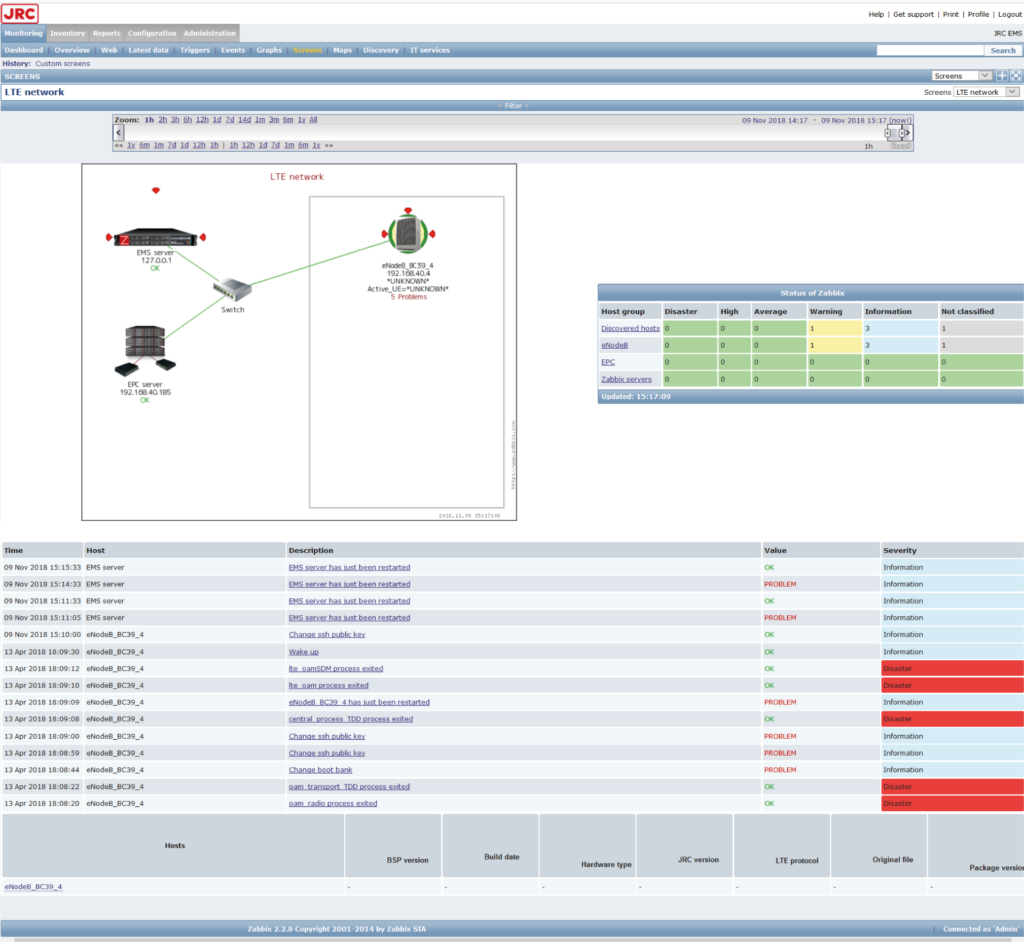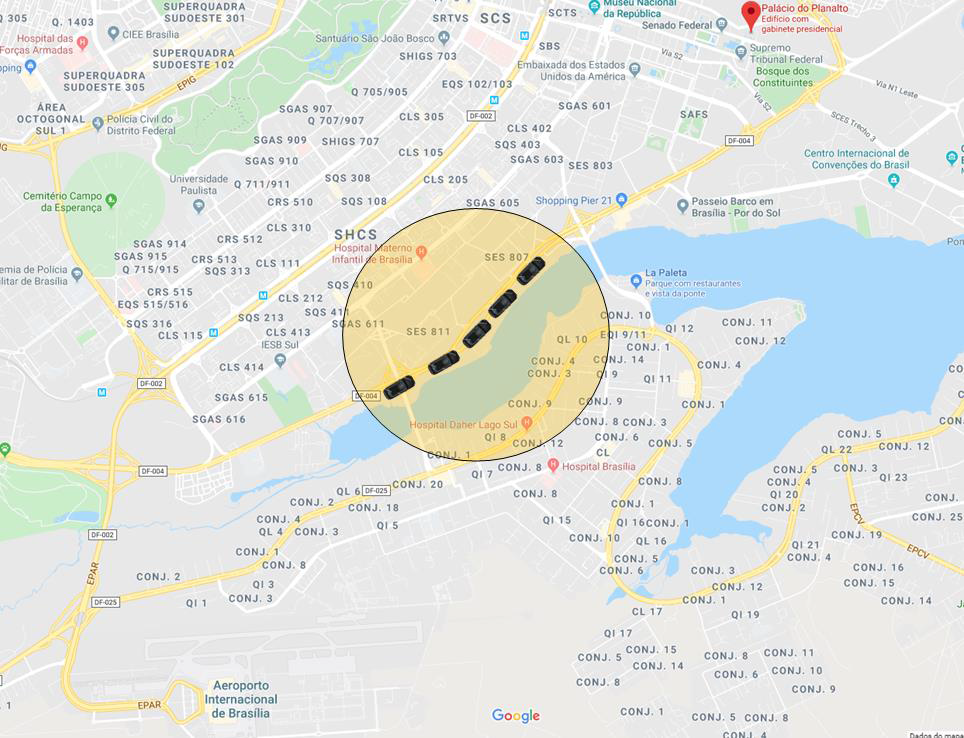Effective emergency and natural disaster management depends on the efficient mission critical voice and data communication between first responders and victims. Land mobile radio system (LMRS) is a legacy narrowband technology used for critical voice communications with limited use for data applications. The new Long Term Evolution is a broadband communication technology that has the ability to transform the capabilities of public safety technologies by providing broadband, ubiquitous, and mission-critical voice and data support.
Long Term Evolution
Long Term Evolution is the most advanced broadband communication technology widely spread. It has a coverage area 10 times larger than WIFI and 100 times larger than 3G, PMR / LMR (Tetra, P25).
JRC's LTE solution is built with the Evolved Packet System (EPS) architecture. The networks most important componentes are: Evolved Packet Core (EPC), Evolved NodeB (eNodeB) and LTE Network Management System (EMS – Element Management System). Their function can be described as:
- EMS: Rremote management and maintenance
- EPC: Network core with multiple features
- eNodeB: Network signal distribution
The schematic above shows a simplified architecture of the JRC system. when the user equipments are connected to the EPC through the E-TRAN network (LTE access network).
An advantage of the JRC's LTE system is that it allows operators to start up quickly with minimum CAPEX, OPEX and scale it up according to the demand.
 Additionally, JRC has developed the Tactical LTE Box. An All in one LTE solution the includes all the systems mentioned before in one box. It allows the quick setup of a mobile LTE network with a few kilometers of range. Such system has many applications, like public and private security.
Additionally, JRC has developed the Tactical LTE Box. An All in one LTE solution the includes all the systems mentioned before in one box. It allows the quick setup of a mobile LTE network with a few kilometers of range. Such system has many applications, like public and private security.
Public LTE x Private LTE
The LTE Technology, or 4G, highly know by citizens, however, the comercial networks used on daily basis are not adequate for situations that require high stability and information security.
Situations like this require a high security level. The first 30 minutes of a fire or active shooter situation usually defines what the next several hours are going to be used for. During those first critical minutes, the first responders need a simple yet advanced communication system that connects with all the human resources that are involved or will be involved and most likely all of them will use cell phones. Those troops need an independent, reliable broadband wireless solution that allows voice, video and data transmission without dependency on any commercial resources. The following table shows a comparison between public LTE solutions and the JRC's private LTE solution.
|
Public LTE |
Private LTE | |
|
Coverage |
Country wide |
Local / Closed |
| Users | > 1M |
<10K |
|
Size / Cost |
Huge core, High cost |
Small core, Low cost |
|
Devices |
Smartphone / Tablet comum |
Smartphone / Tablet profissional Sensor, Câmera de segurança |
|
Applications |
Chamada de voz, Acesso a Internet |
Group calls, transmission, Business Management, IOT |
Solutions applied to:
Element Management System - EMS
As established by the ITU Telecommunication Standardization Sector (ITU-T), the EMS is responsible for five main areas: failures, configuration, accounting, performance and security. In most cases, the EMS is also responsible for management of features and functions of the system, not necessarily the data traffic.
JRC EMS (Element Management System) is a remote management and maintenance system applied to the eNodeB and EPC, and can be operated by a cloud server.
Operation
- Failure control
- Configuration management
- Configuration display
- Management of performance and security
Features
- State of the art technology
- Allows the operator to easily manage the equipments and address failures, configurations, performance and securoty.
Evolved Packet Core - EPC
The LTE network is considered simpler than the previous one because its packets are processed and managed in the EPC Core. Ths setup provides quick response, increasing data transmission and latency.
Our EPC operates according to the 3GPP LTE release 9standard, can be installed on universal OS (Operation System), provides easy to use Graphical User Interface (GUI) and allows quick configuration and operation start.
Operation

- LTE Network Core
- Users autentification
- User access permitions
- Mobility support
Features
- Complete system in one box
- Compact
- Customizable and user profiles
- Services decisions and prioritization
- IP address advanced allocation (static, dynamic, fixed)
- backup system and load balancing
The Evolved Packet Core - EPC is a complex equipment with many features, each managed by a especific system. The ones worth mentioning are:
Evolved NodeB - eNodeB
The LTE network integrates the features of the RCN to the eNodeB and EPC, making the overall system structure much more simple. In LTE, the radio base station was determined by 3GPP as an Evolved NodeB (eNodeB or eNB), which along with all its interfaces builds the E-UTRAN (Evolved UMTS Terrestrial Radio Access Network).
Operation
 RRM (Radio Resource Management): assignment to the UE of physical resources on uplink / downlink, access control and mobility control.
RRM (Radio Resource Management): assignment to the UE of physical resources on uplink / downlink, access control and mobility control.- Data compression: maximize the amount of data that can be transferred in the assigned resource.
- Data protection: protect integrity, encrypt RRC signaling and encrypt user data on the air interface.
- Routing: forwarding of the control plan, signaling traffic to the MME and the user plan, data, to the SGW.
- Package classification and QoS Policy Enforcement : "marking" uplink packages based on subscription information or policy from the local service provider.
Features
- Flexibility
The JRC Compact eNodeB is all-in-one eNodeB which integrates both RF unit and baseband unit, suitable for public safety and private network. and capable of serving up to 255 connected users.
- Compact
The JRC Compact eNodeB is all-in-one eNodeB which integrates both RF unit and baseband unit, suitable for public safety and private network. and capable of serving up to 255 connected users.
- Profitability
The JRC Compact eNodeB is a perfect solution for public safety agencies, enterprises and
WISPs. It maximizes profitable advantages by reducing CAPEX and OPEX.

JRC has designed a Quick Start-up and full turn key solution, including EPC, eNodeB and Antenna on one equipment, which allows the setup a LTE mobile bubble very useful on security and emergency situations. This device is the JRC Tactical LTE Box
JRC Tactical LTE Box
JRC's LTE solutions were developed to provide support adapted to the communication of carriers, emergency services and industrial enterprises. JRC offers a modern, 4G mobile broadband network, system according to the 3GPP standard. A system of simple setup, with advanced tools such as Quick Start-up, full turn-key solution and simplified maintenance. JRC Tactical LTE is JRC's solution that provides a mobile LTE network with all the benefits above with a compact and reliable system.
- Lightweight ruggedize system

- Operated independently and within an existing cellular wireless coverage
- Supports several standard LTE frequencies and several bandwidth capacities
- Suitable for both stationary and on the move implementations
- Gateway de voz para permitir recursos de transferência de voz, vídeo, texto e arquivo
- Ability to host the customer private application
- Single box solution. EPC, eNode, Antenna e Battery in one unit
Features
-
Quick Start-up
Allows operators to start up quickly with minimum CAPEX, OPEX and scale it up according to the demand
- Full Turn-key Solution
From user terminal to billing system.
- Simplest Management
Simplest operation for WISP, Tier-2/3, small public safety operators.
- Professional service
Provides comprehensive system integration and RF planning.
- Custo - Benefício
Reduced CAPEX and OPEX thus Maximizing ROI.
- LTE Frequency bands support
Several commercial and non-commercial bands including VHF band








